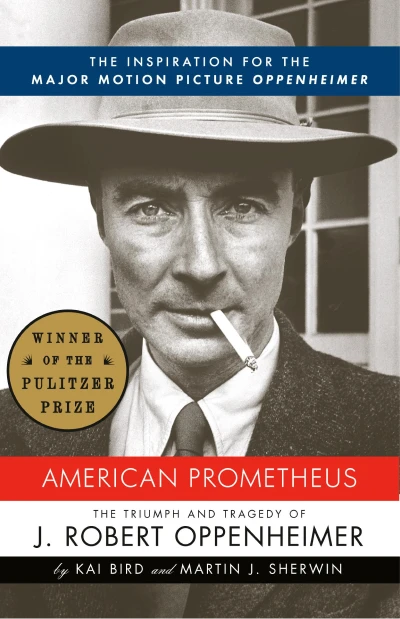
3 Sentence American Prometheus Summary
“American Prometheus” by Kai Bird and Martin J. Sherwin is an amazing biography of Robert Oppenheimer, the brilliant scientist behind the Manhattan Project and the creation of the atomic bomb. We delve into Oppenheimer’s tormented life, exploring his intellect, artistry, and ethical dilemmas while facing political enemies and scientific rivals. It paints a vivid picture of a man whose legacy was both celebrated and tragically marred by the consequences of his work.
Summary Read Time: Less than 12 minutes
Actual Book Length: 721
First Published in: 2005
The book went viral after popular director Christopher Nolan came up with a movie inspired from Robert Oppenheimer’s story. The movie titled “Oppenheimer” created a huge buzz on the box office as well as received acclaimed reviews from critics.
- Part 1
- Part 2
- Chapter 8: “In 1936 My Interests Began to Change”
- Chapter 9: “[Frank] Clipped It Out and Sent It In”
- Chapter 10: “More and More Surely”
- Chapter 11: “I’m Going to Marry a Friend of Yours, Steve”
- Chapter 12: “We Were Pulling the New Deal to the Left”
- Chapter 13: “The Coordinator of Rapid Rupture”
- Chapter 14: “The Chevalier Affair”
- Part 3
- Chapter 15: “He’d Become Very Patriotic”
- Chapter 16: “Too Much Secrecy”
- Chapter 17: “Oppenheimer Is Telling the Truth …”
- Chapter 18: “Suicide, Motive Unknown”
- Chapter 19: “Would You Like to Adopt Her?”
- Chapter 20: “Bohr Was God, and Oppie Was His Prophet”
- Chapter 21: “The Impact of the Gadget on Civilization”
- Chapter 22: “Now We’re All Sons-of-Bitches”
- Part 4
- Chapter 23: “Those Poor Little People”
- Chapter 24: “I Feel I Have Blood on My Hands”
- Chapter 25: “People Could Destroy New York”
- Chapter 26: “Oppie Had a Rash and Is Now Immune”
- Chapter 27: “An Intellectual Hotel ”
- Chapter 28: “He Couldn’t Understand Why He Did It”
- Chapter 29: “I Am Sure That Is Why She Threw Things at Him”
- Chapter 30: “He Never Let On What His Opinion Was”
- Chapter 31: “Dark Words About Oppie”
- Chapter 32: “Scientist X”
- Chapter 33: “The Nim Nim Boys”
- Part 5
- Chapter 34: “It Looks Pretty Bad, Doesn’t It?”
- Chapter 35: “I Fear That This Whole Thing Is a Piece of Idiocy”
- Chapter 36: “A Manifestation of Hysteria”
- Chapter 37: “A Black Mark on the Escutcheon of Our Country”
- Chapter 38: “I Can Still Feel the Warm Blood on My Hands”
- Chapter 39: “It Was Really Like a Never-Never-Land ”
- Chapter 40: “It Should Have Been Done the Day After Trinity”
- Epilogue & Ending
Below is the detailed yet quick American Prometheus book summary covering each learning:
Part 1
Chapter 1: “He Received Every New Idea as Perfectly Beautiful”
From a young age, Robert displayed an intense interest in minerals, poetry, and building with blocks. He was a solitary child, often ill and kept apart from other children by his overly protective mother. Despite this, he was not a spoiled child. His parents encouraged his interests, even when they led to adult pursuits.
For example, at the age of twelve, Robert was invited to deliver a lecture before the New York Mineralogical Club, an honor he accepted with his parents’ encouragement. His early years were marked by a tension between his mother’s strict standards and his father’s gregarious behavior. This tension would shape his personality and future.
Chapter 2: “His Separate Prison”
Oppenheimer’s time at Harvard was filled with a lot of oddity. His intellectual growth was impressive, but his social experiences left his emotional life strained. Harvard’s political culture in the early 1920s was decidedly conservative, and the university imposed a quota to restrict the number of Jewish students. This environment, coupled with his own emotional struggles, led to a series of nearly disastrous existential crises that began in the autumn of 1925 and stretched into the spring of 1926.
Oppenheimer’s time at Harvard was marked by his inability to initiate relationships, remaining aloof and hoping others would make the first move. This emotional turmoil led him to seek help from his old teacher, Smith, who reassured him that he was not alone in his distress. This reassurance provided some solace to Oppenheimer, who found comfort in the fact that someone he admired had also experienced similar struggles.
Despite these challenges, Oppenheimer’s intellectual prowess shone through. He was a superstar in the classroom, and his academic success provided a protective shield against his emotional struggles.
Chapter 3: “I Am Having a Pretty Bad Time”
Robert’s time at Cambridge was marked by a profound internal struggle. He was grappling with the challenges of his new field of study, theoretical physics, and his own emotional instability. He was trying to find his place in the world of academia, but was also wrestling with his own self-doubt and feelings of inadequacy. Despite these struggles, Robert was determined to pursue theoretical physics, a field he felt “just driven to try”.
Robert’s emotional turmoil was not limited to his academic pursuits. He also struggled with his personal relationships. Despite his desire for companionship, he found it difficult to initiate relationships and often felt isolated.
Chapter 4: “I Find the Work Hard, Thank God, & Almost Pleasant”
He travels to Göttingen, a small medieval town in Lower Saxony, where he finds the scientific work to be much more fulfilling than at Cambridge. He describes the work as “hard, thank God, & almost pleasant” .
Despite the occasional relapse into emotional instability, Robert is able to focus on his work. He is particularly drawn to the challenging and complex nature of theoretical physics, which he finds both demanding and rewarding. His time in Göttingen marks a significant turning point in his life, as he begins to gain confidence in his abilities and finds a sense of purpose in his work.
By the end of his time in Göttingen, Robert has made significant strides both personally and academically.
Chapter 5: “I Am Oppenheimer”
After his successful stint in Göttingen, he begins to exhibit signs of homesickness, often comparing the landscapes of Germany unfavorably to those of New Mexico. His American chauvinism is noted by his peers, with one Dutch student complaining, “According to Oppenheimer, even the flowers seem to smell better in America”.
Despite his longing for home, Robert’s time in Göttingen has been transformative. He has proven his intellectual prowess and has begun to establish his identity as a physicist. His emotional struggles have been overshadowed by his academic achievements, and he is beginning to gain confidence in his abilities. As he prepares to leave Göttingen, he throws a farewell party. In the party, he gives a pigskin satchel to Charlotte Riefenstahl, a woman he had met during his time there.
Chapter 6: “Oppie”
We explore Robert’s time in Zurich, which he found to be both productive and stimulating. However, as summer approaches, he yearns for the exhilaration and calmness of Perro Caliente, New Mexico. He has established a rhythm to his life: periods of intense intellectual work followed by renewal in the mountains of New Mexico.
He spends his days hiking and riding through the mountains, and at night, he prepares his lectures by the light of a Coleman lantern. His passion for physics is only matched by his love for New Mexico, a sentiment he expresses in a letter to a friend: “My two great loves are physics and New Mexico. It’s a pity they can’t be combined” (Page 80). Despite his longing for New Mexico, Robert has accepted a position at Caltech in Pasadena, bringing him closer to his beloved desert landscapes
Chapter 7: “The Nim Nim Boys”
In this chapter, we see Robert’s life in Pasadena, where he has accepted a position at Caltech. Despite the economic depression following the stock market crash, Robert’s family is financially stable, allowing him to focus on his work. He lives in a house with a beautiful view of San Francisco and the Golden Gate Bridge, which he describes as “the most beautiful harbor in the world”. His students begin to imitate his quirks and eccentricities, earning them the nickname “the nim nim boys”.
Robert is attracted towards New Mexico and his love truly shows. Despite his passion for physics, he often finds himself longing for the physical sensations and the sense of freedom he experienced during his time in New Mexico. This chapter ends with Robert’s exploration of the Bhagavad Gita, a text that would later play a significant role in his life.
Part 2
Chapter 8: “In 1936 My Interests Began to Change”
This chapter introduces Jean Tatlock, a 22-year-old medical student at Stanford University, who Robert Oppenheimer met in 1936. Jean was a beautiful, intelligent, and politically active woman, who was deeply interested in literature, psychology, and social justice. She was a member of the Communist Party and wrote for the Western Worker, a Pacific Coast organ of the Communist Party. Jean’s activism and social conscience awakened a sense of social responsibility in Oppenheimer. Post this, he became active in numerous Popular Front causes.
Jean Tatlock was a complex woman who held Oppenheimer’s interest. Their relationship was intense and lasted for more than three years. Jean’s activism and social conscience awakened in Robert the sense of social responsibility that had been so often discussed at the Ethical Culture School. He soon became active in numerous Popular Front causes. Oppenheimer’s interests began to change in 1936, as he started to understand how deeply political and economic events could affect people’s lives. He felt the need to participate more fully in the life of the community.
Chapter 9: “[Frank] Clipped It Out and Sent It In”
Frank Oppenheimer, Robert’s brother, was deeply affected by the Depression and the plight of local farm laborers and African Americans. He began reading up on labor history and the works of Marx, Engels, and Lenin. In 1937, he and his wife Jackie saw a membership coupon in the local Communist newspaper, People’s World.
They clipped it out and sent it in, marking the beginning of their overt involvement with the Communist Party. Frank’s approach to physics was hands-on and practical, a contrast to Robert’s more theoretical leanings. He was offered a tuition scholarship at Caltech, thanks to Robert’s influence, solidifying his path in experimental physics
Chapter 10: “More and More Surely”
This chapter delves into the political climate of the time, with a focus on the Communist Party’s defense of the New Deal and its domestic social programs. The party was under attack for its support of Soviet policy, but the authors argue that the real intention of the attack was to disrupt democratic forces and destroy unions.
There’s a lot of ambiguity surrounding the distinction between casual affiliation and actual membership in the Communist Party, particularly in California. The party’s organizational structure led to a blurring of this distinction, with hundreds of people belonging to “clubs” where party business was conducted in a fairly open and informal manner.
Chapter 11: “I’m Going to Marry a Friend of Yours, Steve”
We come to explore the tumultuous relationship between Robert and Jean Tatlock again. Despite their problems, Robert loved Jean and wanted to marry her. However, Jean was often annoyed by Robert’s habit of showering friends with gifts, and she would disappear for weeks or months at a time.
We get to look into Kitty’s life after the death of her husband, Joe Dallet. She was deeply affected by his death and seemed to be in a very unsettled state. In 1938, she met a British-born doctor, Richard Stewart Harrison, whom she had known as a teenager. Seeking stability, Kitty impulsively decided to marry Harrison.
Chapter 12: “We Were Pulling the New Deal to the Left”
This chapter begins with a scene from January 29, 1939, where Luis W. Alvarez, a promising young physicist, reads a news report about two German chemists, Otto Hahn and Fritz Strassmann, who had discovered nuclear fission.
The chapter also discusses Oppenheimer’s home, which was considered a charming, well-designed structure and was his home for nearly a decade. The chapter title suggests a shift in political alignment, with the group pulling the New Deal to the left.
Chapter 13: “The Coordinator of Rapid Rupture”
We see Oppenheimer’s role as a mentor to his students in this chapter. He would often take over and finish a paper if a student was struggling. However, his approach was not always appreciated, as seen when he curtly told a student to put down a paper he was reading, which was later given to another student to work on. The chapter also highlights the reverence for Niels Bohr among Oppenheimer’s circle, with Bohr considered as God and Oppenheimer as his prophet.
Chapter 14: “The Chevalier Affair”
We come across the controversy surrounding Haakon Chevalier, a close friend of Oppenheimer’s. Chevalier had written a novel that was not well-received, and he decided to write a memoir about his friendship with Oppenheimer.
He wanted to discuss their membership in the Communist Party, which he saw as something Oppenheimer should not be ashamed of. The chapter also discusses the social life of Oppenheimer and his wife, who often entertained friends at their home.
Part 3
Chapter 15: “He’d Become Very Patriotic”
Oppenheimer sees a huge transformation once he takes on the role of director of a weapons laboratory for the Manhattan Project. He had to adapt to new work habits and deal with security considerations that were alien to his previous experiences. Oppenheimer’s political beliefs are also discussed, with him stating that association with the Communist movement is not compatible with working on a secret war project.
Despite his past associations, Oppenheimer had become a changed man due to his responsibilities at Los Alamos. He was now the bomb laboratory’s director, and the success of the project rested on his shoulders. His wife, Kitty, is also mentioned as having ambitions for Oppenheimer to gain fame and recognition, which Groves believed would ensure his loyalty to the United States.
Chapter 16: “Too Much Secrecy”
There is intense secrecy surrounding the Manhattan Project and it had a huge impact on Oppenheimer. The chapter begins with Lieutenant Colonel Lansdale’s efforts to reel Oppenheimer into his security web, despite objections from others like Boris Pash. Oppenheimer was granted security clearance, irrespective of the suspicions surrounding him.
However, this decision was not universally accepted, with many of Groves’ subordinates not sharing his trust in Oppenheimer. The chapter also highlights Oppenheimer’s unique approach to loyalty, as he chose to stake his reputation as a scientist rather than pledging blind loyalty to the United States.
Chapter 17: “Oppenheimer Is Telling the Truth …”
Oppenheimer is surrounded by a lot of trust issues. Despite the suspicions and objections, General Groves and Lansdale believed that Oppenheimer was telling the truth. However, this trust was not shared by all, with some questioning how Oppenheimer would react if he discovered communists within his team. Oppenheimer’s emotional response to the potential failure of the implosion explosives is also revealed, highlighting the immense pressure he was under.
Chapter 18: “Suicide, Motive Unknown”
This chapter takes a tragic turn with the suicide of Jean Tatlock, a significant figure in Oppenheimer’s life. Tatlock’s death was a profound loss for Oppenheimer, who had wanted to marry her and remained a loyal friend and occasional lover even after his marriage to Kitty.
The chapter explores the circumstances of Tatlock’s death, the impact it had on Oppenheimer, and the ensuing investigations. The chapter also highlights the speculation and conspiracy theories that arose following Tatlock’s death. It also included suspicions of foul play and potential involvement of Boris Pash, a veteran anti-Bolshevik turned counterintelligence officer.
Chapter 19: “Would You Like to Adopt Her?”
The personal life of Oppenheimer, focusing on his relationship with his children is explored on this one. Kitty, Oppenheimer’s wife, leaves for Pittsburgh. She takes their son Peter with her but leave their four-month-old baby girl, Toni, in the care of their friend Pat Sherr. Oppenheimer, engrossed in his work, only visits his daughter twice a week. The strain of his work is evident, with his health deteriorating significantly. However, during one of his visits, Oppenheimer acknowledges his feelings of guilt about not being able to give his child the attention she deserves, revealing a man of great conscience.
Chapter 20: “Bohr Was God, and Oppie Was His Prophet”
The narrative shifts back to the development of the atomic bomb. The discussions around the morality and politics of the atomic bomb continue, with Robert Wilson, the chief of the lab’s experimental physics division, proposing a formal meeting to discuss the matter more fully.
Despite initial resistance from Oppenheimer, the meeting takes place, and Oppenheimer dominates the discussion. He argues that the world must know about this new weapon to prevent the next war from being fought with atomic weapons. His argument, drawing on Niels Bohr’s vision of “openness,” is compelling to his fellow scientists.
Chapter 21: “The Impact of the Gadget on Civilization”
The discussion on the implications of the atomic bomb continues. The scientists at Los Alamos grapple with the moral and political implications of their creation. Oppenheimer argues that the war should not end without the world knowing about this new weapon. The worst outcome, he suggests, would be if the gadget remained a military secret, leading to the next war being fought with atomic weapons. The scientists come forward to decide the point where the gadget could be tested.
Chapter 22: “Now We’re All Sons-of-Bitches”
The moments leading up to the testing of the atomic bomb are quite intese. The tension is palpable as the countdown begins. Richard Feynman, a key member of the team, watches the explosion from a distance. The sight of the mushroom cloud is described as “terrifying” and “not entirely undepressing.” Oppenheimer, reflecting on the event, recalls lines from the Hindu scripture, the Bhagavad-Gita, saying, “Now I am become death, the destroyer of worlds.” The chapter ends with a poignant comment from Ken Bainbridge, who says to Oppenheimer, “Now we’re all sons-of-bitches”.
Part 4
Chapter 23: “Those Poor Little People”
This part begins with the aftermath of the Trinity test, where the mood at Los Alamos began to change. Oppenheimer was seen to be in a contemplative state. He was aware of the potential targets in Japan and the devastating impact the weapon would have. Despite his somber mood, Oppenheimer was working hard to ensure the bomb would be dropped efficiently over Japan, providing precise instructions to the military officers.
Oppenheimer had hoped that the bomb’s existence and its impending use against Japan would be openly discussed with the Russians. However, he was disappointed to learn that Truman had only made a cryptic reference to the bomb during the Potsdam conference.
On August 6, 1945, the uranium bomb was dropped over Hiroshima. The news was met with a mix of relief, celebration, and horror among the scientists at Los Alamos. Oppenheimer himself was reported to be a “nervous wreck”. The chapter ends with Oppenheimer drafting a final report to Secretary Stimson, expressing his pessimism about the future of atomic weapons and emphasizing the need to make future wars impossible.
Chapter 24: “I Feel I Have Blood on My Hands”
Oppenheimer’s grows into disillusionment and guilt over the consequences of his work on the atomic bomb. He begins to express regret, stating that he feels he has “blood on his hands.” Truman, misunderstanding Oppenheimer’s sentiments, sees this as an attempt to create an alibi for his actions. This chapter also marks the beginning of Oppenheimer’s alienation from the President of the United States.
Chapter 25: “People Could Destroy New York”
Oppenheimer’s concern about the potential misuse of nuclear technology increases. He fears that the destructive power of the atomic bomb could be used to destroy cities like New York. This fear is further exacerbated by the growing tensions of the Cold War and the proliferation of nuclear weapons. Oppenheimer’s concerns are met with resistance and misunderstanding, further isolating him from the political and scientific communities.
Chapter 26: “Oppie Had a Rash and Is Now Immune”
Oppenheimer’s life takes a turn as he tries to balance his teaching responsibilities at Caltech with his growing political commitments. His heart isn’t in teaching anymore, and he’s constantly distracted by other matters. He also faces health issues, collapsing unconscious on the bathroom floor after taking a sleeping pill. This chapter also hints at Oppenheimer’s growing sense of foreboding, a “beast in the jungle” that he feels is looming over him.
Chapter 27: “An Intellectual Hotel ”
Oppenheimer takes up the position of director at the Institute for Advanced Study in Princeton. It’s a role that provides him with a prestigious platform and easy access to nuclear policy-related committees in Washington. The Institute, described as an “intellectual hotel,” is a place for transient thinkers to rest, recover, and refresh themselves.
However, Oppenheimer’s plans for the Institute often meet with resistance, particularly from the mathematicians. Despite the challenges, Oppenheimer sees the Institute as an opportunity to bring together science and humanities. He considers it as a chance to create a multidisciplinary understanding of the human condition.
Chapter 28: “He Couldn’t Understand Why He Did It”
We circle back into Oppenheimer’s complex personal life and his relationships. The chapter discusses his interactions with the FBI and the surveillance they had on him. But it also reveals that Oppenheimer was not aware of his affair with Ruth Tolman. His wife, Kitty, was intensely jealous of his affections and was resentful of anyone who got involved with Robert. Kitty also confided that Oppenheimer had no sense of fun and play and was overly fastidious. The chapter portrays the stark contrast in their personalities, with Kitty being extreme in her passions, whereas Robert could be surprisingly disengaged.
Chapter 29: “I Am Sure That Is Why She Threw Things at Him”
We explore the tumultuous relationship between Robert and Kitty. Kitty was described as being accident-prone, with her drinking contributing to a string of such episodes. Robert reacted to his wife’s self-destructive behavior with stoic resignation. Kitty was also described as being impatient with their son, Peter, and Robert invariably took Kitty’s side in these arguments. Kitty has intense and ephemeral friendships. She has their weird need to hurt people, habit of discussing her personal life, including her sex life, with her friends.
Chapter 30: “He Never Let On What His Opinion Was”
We come back to explore Oppenheimer’s professional life and his role as the director of the Institute for Advanced Study in Princeton. Despite the demanding nature of his job, Oppenheimer managed to divide his time between Institute business, intellectual pursuits, and traveling for speeches and classified meetings in Washington.
The chapter also discusses the aftermath of the Super debate and how it affected Oppenheimer’s morale. Despite the challenges, Oppenheimer chose to remain an insider, albeit one who was increasingly outspoken and increasingly suspect.
Chapter 31: “Dark Words About Oppie”
We see the growing tension between Oppenheimer and Lewis Strauss, a member of the Atomic Energy Commission. Oppenheimer was facing financial difficulties due to legal bills, and he approached Strauss for help. However, Strauss was unsympathetic and declined to assist. This incident further strained their relationship, and Oppenheimer knew he could count on Strauss’s hostility from then on. This chapter highlights the political and personal challenges Oppenheimer was facing during this period.
Chapter 32: “Scientist X”
Oppenheimer faced increased scrutiny from the FBI, HUAC, and the Justice Department. The FBI had interviewed him twice in his Princeton office, and he was worried about his past affiliations with the Communist Party becoming public. He was particularly concerned about being linked to Joe Weinberg, who had been identified as “Scientist X,” a Soviet spy. This chapter underscores the mounting pressure and suspicion Oppenheimer was facing.
Chapter 33: “The Nim Nim Boys”
Oppenheimer had long harbored a sense of foreboding about his future, which he likened to the “beast in the jungle” from Henry James’ short story. He felt as though he was a hunted man, and he believed that if there was a “beast in the jungle” waiting for him, it was Lewis Strauss.
This chapter also discusses a speech Oppenheimer gave in New York. It was essentially an unclassified version of a disarmament report he and Bundy had recently sent to the Eisenhower Administration. This speech was likely to anger his political enemies in Washington.
Part 5
Chapter 34: “It Looks Pretty Bad, Doesn’t It?”
Oppenheimer receives a letter from his old friend Victor Weisskopf, who expresses support and encouragement for him during his predicament. Weisskopf tells Oppenheimer that he is fighting their fight and that he represents the spirit and philosophy of their country. Oppenheimer is preparing his defense against the charges leveled against him by the AEC. He assembles a legal team and spends intense days drafting his statement and discussing the case. However, he seems almost serene during this period, showing incredible stamina.
Chapter 35: “I Fear That This Whole Thing Is a Piece of Idiocy”
Oppenheimer is questioned about his previous statements and actions. He admits to lying and fabricating details, which he attributes to idiocy. Oppenheimer explains that he was impelled by concerns at the time, but he should have told the truth immediately and accurately. He admits to feeling cornered and panicky during the questioning, responding unthinkingly like a soldier in combat.
Chapter 36: “A Manifestation of Hysteria”
Oppenheimer’s hearing is described as a manifestation of the hysteria of the times over communism, which is seen as extremely dangerous. He is excused from the witness chair on the third day of the hearing, and his attorney, Lloyd Garrison, gives a closing statement. Garrison speaks of the anxiety in the country and warns against the destructive nature of the security apparatus.
Chapter 37: “A Black Mark on the Escutcheon of Our Country”
Oppenheimer returns to Olden Manor, tired and irritable. He knows things have gone badly and there’s not much he can do but wait for the Gray Board’s judgment. He believes the case will not come to a quiet end as all the evil of the times is wrapped in this situation. During this time, he and Kitty spend hours watching the Army-McCarthy Senate hearings on television. This serves as a painful reminder of his own ordeal.
Chapter 38: “I Can Still Feel the Warm Blood on My Hands”
The narrative takes us to the early 1960s, a time when Oppenheimer was no longer considered a political pariah, especially with the return of Democrats to the White House. The Kennedy Administration, while not willing to bring him back into government, viewed him as an honorable man who had been martyred by Republican extremists. The chapter also mentions Oppenheimer’s reaction to the assassination of President Kennedy. Upon hearing the news, Oppenheimer predicted that “things are going to come apart very fast”.
Chapter 39: “It Was Really Like a Never-Never-Land ”
This chapter delves into Oppenheimer’s life after the Manhattan Project, particularly his time spent on the island of St. John in the Virgin Islands. Beginning in 1954, the Oppenheimers spent several months each year living on this tiny island. Robert relished this self-imposed exile, living as if he were a social outcast.
The Oppenheimers initially stayed at a small guest house at Trunk Bay on the island’s north shore. But in 1957, Robert bought two acres of land on Hawksnest Bay. It was a beautiful cove on the northwest tip of the island. The chapter also describes how Robert would invite anyone he met for drinks. It often turned into dinner, and he would recite poetry, becoming a simple philosopher king adored by his ragtag followers of expatriates, retirees, beatniks, and natives.
Chapter 40: “It Should Have Been Done the Day After Trinity”
Oppenheimer was no longer a political pariah, and liberal Democrats saw him as an honorable man martyred by Republican extremists. In April 1962, McGeorge Bundy, the former Harvard dean and now national security adviser to President Kennedy, had Oppenheimer invited to a White House dinner.
The chapter also mentions an interview where Oppenheimer was asked about Senator Robert Kennedy’s recent proposal that President Johnson initiate talks with the Soviet Union to halt the proliferation of nuclear weapons. Oppenheimer’s response was that it was “twenty years too late… It should have been done the day after Trinity”.
Epilogue & Ending
The epilogue provides a look at the lives of Oppenheimer’s family and friends after his death. Kitty, Oppenheimer’s wife, began living with Bob Serber, a close friend and former student of Oppenheimer. However, she never let anyone call Serber “Robert,” as there was only one Robert in her life. Kitty’s life took a tragic turn when she fell ill during a sailing trip and died in Panama City in 1972. Her ashes were scattered near Carval Rock, the same spot where Robert’s urn had been sent to the sea’s bottom in 1967.
Frank Oppenheimer, Robert’s brother, made a significant contribution to academia and public education. He was appointed to the physics department at the University of Colorado and later won a prestigious Guggenheim Fellowship.
The epilogue also touches on the lives of Oppenheimer’s children. Peter Oppenheimer moved to New Mexico and made a living as a contractor and carpenter. He kept his familial connections to the father of the atomic bomb a secret, even when he went canvassing door-to-door as an environmental activist. Toni, Oppenheimer’s daughter, had a more challenging life.
After her father’s death, she struggled with her career and personal life. She eventually moved back to St. John, where she lived a solitary life. Tragically, she took her own life in 1977, leaving her house to the people of St. John. The beach cottage is now gone, but in its place stands a community house on what is now called Oppenheimer Beach.





